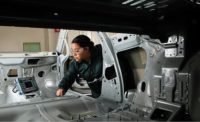Trends in Equipment Budgeting
While equipment budgets are as important as ever, the new budget seeks to determine ROI first with rented equipment

Joe Lendway knows a thing or two about the importance of maintaining quality in a full-scale operation—and therefore the importance of budgeting for it. Lendway is the quality manager at Top Tool, a manufacturer of precision metal stamping components whose high standards earned it 2013’s Quality Plant of the Year award.
The Minneapolis-based company is relatively small, but it utilizes an equipment budgeting process that transcends size: The company starts with pinpointing where its equipment can be improved; identifying sources and equipment operations to address the needs; selecting a source for the equipment; performing Return on Investment (ROI) calculations to support the purchase of the equipment; and presenting this information to top management for funding.
This method is echoed among manufacturers worldwide. As the 2013 Quality Spending Study reveals, manufacturers are placing increasing importance on assessing how to best meet quality needs. In the past year, a little more than half of respondents said quality was “somewhat” or “much more important” than a year ago, and while the majority expect their fiscal 2013 spending to be the same as budgeted in 2012, a third of respondents expect 2014’s spending to go up as much as 25%. As our readers survey suggests, investing in quality could be on the rise.
The way that investment takes place is changing, however. Some companies are seeing value in renting equipment.
“Since we are a job shop supporting our customers ever-changing needs, our equipment needs may change based on the needs of our customers,” Lendway explains. “These changes may occur at any time, based on changing customer requirements.”
While Top Tool currently does not rent equipment, companies who are as cognizant of rapidly changing customer demands as Lendway are taking the rental route more often. This growing trend—as well as certain standby metrology equipment being reinforced as perennial budget staples—shapes equipment budgeting today. Frost & Sullivan Market Research Analyst Aravind Govindan and Hexagon Metrology’s director of North American Sales, Jeff Freeman, took some time to tell us why.
Quality Magazine: How popular is renting equipment becoming instead of buying it?
Aravind Govindan: There is certainly a growing trend in metrology companies renting metrology equipment for quality inspection activities.
The metrology market has reached a mature state and is growing at approximately 3 to 4% annually. Showcasing organic growth year-over-year is quite a bit of a challenge, thus companies are slowly trying to build a stronger service portfolio and remain a one-stop-shop for metrology solutions. Companies render services, such as renting equipment to end users.
Erratic growth trends in the automotive industry and volatile global economic conditions have reduced the demand in the dimensional metrology equipment market. End users prefer to remain cautious by adopting a wait-and-see approach. Not just OEMs, but most companies involved in the automotive supply chain completely cut down on new equipment purchases.
Small and medium sized manufacturers in automotive, aerospace and machine shops form a sizeable target market for the metrology equipment rental market. Such small and medium-sized end users do not have budgets to procure metrology equipment. Machine shops in particular manufacture different components based on a client’s requirements. Machine shops do not invest heavily in procuring a wide range of dimensional metrology equipment. If the client requires machine shops to carry out quality inspection tasks, based on the level and type of inspection, machine shops rent the appropriate metrology equipment.
Jeff Freeman: Companies are more frequently turning to rental equipment, and not just equipment, but metrologists to operate it as well. Short term equipment rental is an excellent option to manage short-term production surges that create bottlenecks in the metrology department. Using a contract metrology services company that supplies skilled operators with the equipment is a sound financial strategy to manage short-to-medium term requirements for personnel, without incurring the costs of hiring full-time employees. Another reason companies rent metrology equipment short-term is to determine if it suits their applications, as a way of deciding if they should make a purchase.
If the equipment being considered is not currently in the budget, rentals provide an ideal opportunity to perform a real-world ROI analysis so they can justify the purchase. In other words, try the equipment in the process to see what measurable benefits are obtained, such as an increase in cycle speed or a reduction in scrap. Armed with real-world data, it is easier to perform the return on investment calculation. If the ROI is strong enough, it can be easier to secure the capital budget sooner.
Another reason to rent is that rental equipment often comes under an expense budget and not a capital budget, and some companies may have more flexibility using expense budgets to rent equipment.
Companies also want the flexibility of renting equipment and short-term staff to take advantage of market opportunities that may suddenly appear and that they were not otherwise prepared to take advantage of. Sourcing rental equipment and personnel allows the company to secure the business immediately. Hexagon Metrology has a dedicated contract services business offering rental equipment and short-term personnel precisely because our customers requested it.
QM: What types of equipment are companies ensuring their budgets allow for?
JF: Metrology technology options continue to grow. There is, and always will be, a need for stationery Coordinate Measuring Machines (CMMs). These CMMs—whether they are bridge, gantry or horizontal—have the accuracy, sizes and capabilities to perform certain tasks better than any other technology currently. Portable metrology has gained widespread acceptance.
As the capability of metrology hardware has evolved, metrology software has also grown more sophisticated to support the capabilities of the hardware. Metrology hardware and metrology software are mutually dependent: hardware capability without software capacity to process the collected data benefits nobody. One area where this situation has been evident is non-contact laser scanning. At one time, both the laser scanning hardware and the data collection software were not particularly capable and they often were poorly integrated. Today, far more capable integrated solutions are readily available and competitively priced, and as a result they are in great demand and affordable to anyone who needs this capability.
AG: CMMs have been around for several decades. These are known for exhibiting high-precision results, and end users across the globe are familiar with the technology and prefer using it. CMM prices can range from $40,000 to $1 million. However, growing demand for flexibility offered by scanning- and vision-based technologies are winning over the confidence of end users by showcasing flexibility and reliable results.
These scanner- and vision-based technologies are integrated along with CMMs to provide customized dimensional metrology solutions. The CMM segment will continue to remain the biggest technology in the dimensional metrology market.
QM: What do small, medium and/or large-sized manufacturing company’s annual equipment budgets typically look like?
JF: Most companies have an annual budgeting process. Smaller shops, where the owner runs the business, may be a bit less formal and this is often an advantage for the business; the owner sees the immediate benefit to the business and decides to makes the purchase. In larger companies, with formalized annual budgeting, it may take one of more budgeting cycles to procure the equipment. Metrology technology is often not the first priority so, in my experience, we have to work harder to justify the purchase.
AG: Larger companies continue to invest 10% of their annual revenue into R&D. Q
Genevieve Diesing is Senior Editor of Quality.
Looking for a reprint of this article?
From high-res PDFs to custom plaques, order your copy today!






